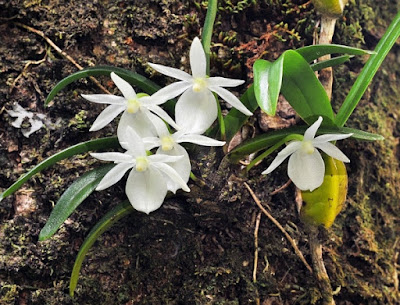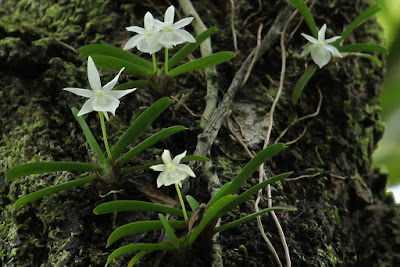Angraecum cucullatum is found the Mascarene Islands, Mauritus and Reunion. It grow in dense forest on old tree trunks usually 50-100 cm above the ground.
Angraecum cucullatum also called as The Cowl-Carrying Angraecum, Aerobion cucullatum, Angorchis cucullangis, Angorchis cucullata, Angorchis fragrangis, Macroplectrum cucullatum, Perrierangraecum cucullatum, is a species of the genus Angraecum. This species was described by Louis Marie Aubert Du Petit-Thouars in 1822.
IDENTIFY ANGRAECUM CUCULLATUM ORCHID PLANT
Angraecum cucullatum is found the Mascarene Islands, Mauritus and Reunion. It grow in dense forest on old tree trunks usually 50-100 cm above the ground.
It is a mini-miniature sized, warm growing epiphytic orchid with thickened stems carrying 2 to 5 apical, rigid, ligulate, V-shaped in cross section unequally bilobed apically leaves.
The Cowl-Carrying Angraecum blooms in the late spring and early summer on a slender, 3 to 4 cm long, single flowered inflorescence.
ANGRAECUM CUCULLATUM ORCHID PLANT CARE AND CULTURE
Cultural information should only be used as a guide, and should be to be adapted to suit you. Your physical location; where you grow your plants, how much time you have to devote to their care, and many other factors, will need to be taken into account. Only then can you decide on the cultural methods that best suit you and your plants.
Light:
Angraecum cucullatum needs a light level of 18000-25000 lux. Light should be filtered or diffused, and plants should not be exposed to direct midday sun. Strong air movement should be provided at all times.
Temperature:
Summer days temperature at average 21°C, and nights temperature at average 13-14°C, with a diurnal range of 7-8°C.
Humidity:
The Cowl-Carrying Angraecum need the humidity of 75-80% most of the year, but averages fall to 65-70% for a few months from early spring to early summer.
Substrate, growing media and repotting:
Angraecum cucullatum may be grown in shallow, well-drained containers or mounted on tree-fern slabs. Mounted plants need high humidity, however, and during hot, dry weather they may need several waterings a day.
If it is difficult to keep mounted plants moist enough, they may be grown in a shallow pot or basket filled with a very open, fast-draining medium that has excellent drainage, is well aerated, and allows the medium to dry fairly rapidly after watering.
You can use medium-sized fir bark or shredded tree-fern fiber and add varying amounts of chunky perlite and/or chopped sphagnum moss to keep the medium open and retain some moisture. Including charcoal in the mix also holds the medium open and prevents souring in the pot.
Plants should be repotted immediately if the medium starts to break down or whenever the plant outgrows its container. Repotting should be done just as new roots start to grow. This enables the plant to become reestablished in the shortest possible time.
Watering:
Rainfall is moderate to heavy in summer and autumn, but averages are somewhat lower in winter and spring, with the driest months occurring in spring. The cultivated plants should be watered heavily while actively growing, but drainage must be excellent, and conditions around the roots should never become stale or soggy.
Fertilizer:
1/4-1/2 recommended strength, applied weekly when plants are actively growing. You can use a balanced fertilizer throughout the year; but also can use a high-nitrogen fertilizer from spring to midsummer and then switch to one high in phosphates in late summer and autumn.
Rest period:
Winter days temperature at average 15-16°C, and nights average 8°C, with a diurnal range of 7°C. Water should be reduced for Angraecum cucullatum plants in winter and spring, but the should not remain completely without water for long periods. Fertilizer should be reduced when water is reduced, with both increased gradually when new growth starts.















COMMENTS